
Deco Rides’ High-Profile Designs
By Steve Temple
Photos by Steve Temple and Courtesy of Terry Cook
For those car builders who aren’t into art history, art deco refers an elegant style of decorative design that emerged in the ‘30s between the World Wars, when rapid industrialization was transforming culture. Of particular relevance to car builders is its embrace of technology.
That movement aptly describes Deco Rides as well, a company founded by former Hot Rod editor Terry Cook (who also now hosts a massive car event called Lead East). While he reveres modern technology, he merges it with traditional themes in remarkable and innovative ways.
This artistic bent is actually a form of protest. Looking back at the early history of hot rodding and customizing cars, rodders were once outlaws. But just as tattoos were initially considered emblems of a rebellious and anti-social attitude—and now have become a popular form of body art—so too have many street rods.
“Hot rods like ‘32, ‘34, ‘37 and ‘40 Fords are absolute things of beauty, but when I go to a big rod runs and see literally hundreds of them, they all begin to look the same, like Xerox copies of rods built 50 years ago,” Cook notes. “I crave any car that has the right look, but at the same time is fresh and different.”
That means stirring up a whole new recipe: hot rods combined with classic automotive styling. What inspired this unusual combination?
One car in particular comes to mind, a Vanvooren-bodied Bugatti Type 57 C, built for the Shah of Persia. He was especially struck by its enclosed pontoon fenders, along with those “sweet little items—the brightwork, the trim, the sculpture.”
All of them put together became an epiphany for Cook. “That’s what changed my life, those kustoms built by European coachbuilders,” he recalls. “Coachbuilt cars for concours events from ’35 to ’39, that was the apogee of automotive styling.”
As much as Cook wanted to put a different spin on them, he wouldn’t dare tamper with their originality. “I never could afford to own a Delahaye or Bugatti; and if I could, I wouldn’t cut it up.”
Instead, he put a fresh twist on his old favorites: “We’re dragging these 1930s classics into the 21st Century with a hot rod flavor, gusto and verve. In doing so, we’re paying tribute to these great stylists and craftsmen,” he insists. “I call them ‘Tribute Rods’—we start with a classic and then smoke it over.”
Which makes for opulent rods with a sizzling sense of style, “mutant stuff,” Cook quips. His layering of disparate flavors is actually a somewhat common technique, at least in a general sense. As many car designers admit, there’s nothing new under the sun, just different mixes of familiar lines with classic appeal. Whatever their origins, his creative concoctions have whetted the appetites of numerous collectors over the years, and gained him the worldwide notoriety. How he got there is as unusual as his cars.
Although initially a car magazine editor by trade, he harbored a not-so-secret yearning to become a designer and builder. (After all, what car guy hasn’t felt likewise, sketching out dreams on a note pad?) The inspirations for his designs are numerous, from European coachbuilders to numerous automotive museums to renowned designers.
Jean Bugatti and Georges Pauline are two of Cook’s four favorite designers, with Russian Jacques Saoutchik and Italian Guiseppi Figoni being the other two. And he admits to spending countless hours poring over magazines, books and web sites on hot rods and other “swoopy” automotive shapes. All told, he has a definite preference for marques like Auburn, Bugatti, Cord, Delahaye, Delage, Deusenberg, Maybach and Talbot Lago.
“To me the best-looking cars were built in the mid- and late 30s, before the slab-sided look arrived, back when fenders were distinct and separate design elements.”
So where did Cook begin? He started out with some simple ingredients back in 1990 with a postcard of an 810 Cord that he bought at the Auburn-Cord-Duesie Museum in Indiana. He took it home and chopped it and dropped it with an X-Acto knife and Scotch tape. Together, with influence from the work of Joseph Figoni of Paris, it inspired him to buy a ‘41 Hupp Skylark. That was the seed that blossomed to become his company Deco Rides, along with some other high-flying endeavors.
His first car, the aptly named Scrape, took more than four years to complete. Working with Ramsey Mosher of Ram’s Rod Shop in Dover, Delaware, he started out with a design from E. L. Gregory, a ’39 Lincoln Zephyr, and grafted on the nose of a ’40-’41 model. While some purist collectors groaned at the thought of this cross breeding, other Zephyr fans applauded his efforts, and in fact inspired Cook to combine these two design elements into a “phantom” car that never existed in production form.
Building the car required a different chassis, a ’78 Caprice wagon he purchased for $350, and stripped down to the frame. To achieve that signature stance, he hired Dave Cronk, who Z’d the frame at the flywheel area and lengthened it to fit the Lincoln’s wheelbase. With the new rails sitting flat on the floor, he lowered the body onto the rails so it straddled them at ground level, and then welded the whole thing together. With the ride height now set at rock bottom, the trick would be to lift up the car enough to get it to drive down the road. That’s where Mosher took over, literally from the ground up, consuming four years and 4,000 hours to complete the car under tight wraps.
The saga of what went into this project has been told in Cook’s own words with great detail and fluency. Scrape went on to have an astounding effect on all who saw it. He recalls on two separate occasions the car received standing ovations as it pulled into the spectator area. And one those wild applauses took place at an event where the competition included mega-buck classic and exotic sports cars.
While some of Cook’s creations sell in solid six-figure territory, (Bob Petersen, who founded the auto museum bearing his name, purchased Scrape for $275,000) he had the foresight to make molds off the body of the car he had designed so he could reproduce coupes, and a new convertible, in fiberglass composite. He went on to produce more than 100 bodies by his last count, which have sold all over the world, from Moscow to Dubai to Australia.
Even with all the accolades and demand for his designs, he’s never let it go to his head. As one example of his sense of whimsy, note the outboard engine emblem on Scrape’s engine cover.
“Evinrude—that’s a joke,” he chuckles. “Everybody takes their cars too seriously. Scrape has a small-block Chevy with just a two-barrel carb.”
Another lighthearted nod is in the name of his Bugnotti roadster. This reference to the Bugatti name, along with a simultaneous negation of it (“not a Bugatti”), is more than just a play on words. It’s also a subtle dig towards Bugatti’s corporate parent Volkswagen and its attitude toward reproductions.
Cook’s irreverence is obvious as well in a mocked-up magazine cover on his web site: Sheep Rodder and Lemmings Motor News, a sarcastic comment on the conformity he decries in the rod industry. He should know, considering his longtime experience in the field, and his hard-earned street creds.
Cook didn’t start out as a globetrotting designer. His early days in New Jersey consisted of joining hot rod clubs, writing for local drag-racing magazines, and working as a flag starter at a local drag strip. He had a passion for dragsters at one time, but after seeing two racers killed on the track right in front of him, he changed gears, toiling as a scribe for Car Craft and later serving as editor of Hot Rod for a couple years. Those gigs led to some other publishing ventures, but after they stalled, he founded an automotive event called “Lead East”— the “World’s Biggest ‘50s Party”—which is still held every year on Labor Day in Parsippany, New Jersey.
Evidently car show management was more successful than publishing, as it allowed him to produce Scrape. “But I’m a few cars beyond it now,” he admits. “I have a limited attention span.” He’s been going through an evolution, and now has an affinity for phantom coupes. He still has a soft spot for kustoms, though. “Scrape is the epitome of a my kustom era.”
Taking that design to whole new level is a Sedan Delivery version, which transports a customized chopper bike inside, styled to match the car. The bike’s front wheel serves as an armrest between the driver and shotgun front bucket seats. With a front-wheel drive platform that eliminates the differential hump in the rear floorboard, a motorized ramp can be used to get the bike in and out of the vehicle. The motorcycle is rolled onto the ramp, strapped in position, and then the ramp and bike are automatically retracted into the car at the touch of a switch. The rear door then closed automatically using linear actuators.
Cook says a car dealer from Dubai purchased the car at the 2010 Pebble Beach, where it was simply parked outside the fence, within sight of a crowded walkway. Even though he considers this event to be the highlight of the year, Cook occasionally encounters some resistance. “They turn up their noses at hot rodders,” he laughs, shaking his head. But he was recently vindicated by a select group of collectors: “I’ve been invited to join the Delahaye club—I thought I’d be burned at the stake.”
The Bella Figura Bugnotti coupe also debuted at Pebble Beach to rave reviews. Produced by Cook’s other company, Delahaye USA, this carbon fiber creation was inspired by the classic Type 57S. While never intended to reproduce a real Bugatti, it’s a tribute, like other Cook cars, in this instance to Ettore’s son Jean. Under development for more than a year using digital technology from Revolution Design Studios, it employs a vacuum infusion process from carbon fiber specialists 3 G Services Inc. The result is a carbon fiber finish where the weave of the cloth is evident through a clear coat.
"“I’m not gonna put a freakin’ Chevrolet in my car—then it’s just another street rod, I’m trying to build cars that exude class.”
– Terry Cook
For those who prefer a more conventional finish, however, there’s a choice of a painted body of carbon fiber and composite, or all composite. Available as “turnkeys” or the bare body and rolling frame for the build-it-yourself enthusiast, the models available include a coupe, a drophead coupe with folding convertible top mechanism or a targa-top version.
The ever-restless Cook has a number of other projects in the works. “There are a dozen cars in my head,” he reveals. One that’s moving ahead is called the Sultan, inspired by the astounding artistic expressions of Saoutchik. Working with John Caswell, an honors graduate of the famed Art Center College of Design in Pasadena, California, Cook had him design a massive 17-foot long roadster with elongated, metallic spears sweeping down the sides. The extraordinary bodywork is going to be handled by Marcel of Custom Metal (who has also done work for automotive luminaries such a Boyd Coddington and Chip Foose). And its custom chassis features Corvette C5 running gear, along with a BMW V12 engine. Why a Bimmer?
“I’m not gonna put a freakin’ Chevrolet in my car—then it’s just another street rod,” he exclaims. “I’m trying to build cars that exude class.”
Do they ever. And that’s right in keeping with his company philosophy. Named as a tribute to Emil Delahaye who started manufacturing cars in Tours, France in 1879, Delahaye USA has no connection with the original Delahaye GFA (Générale Française Automobile). Until that firm went out of business in 1954, it produced some of the most elegant cars of all time for a golden era lasting some 75 years.
Today, Delahaye USA pays homage to world's top coachbuilders and carrying on their classic tradition, recreating their most breathtaking, delicious designs of all time. Drawing on a talented team of craftsmen and engineers, the company can build even higher quality cars today than most French coachbuilders of the 1930s. That makes them not only a tribute, but also a substantial enhancement of the some of the most remarkable cars ever created.
One of the latest is the Pacific, a play on words, since it was inspired by Ralph Lauren's famed 1937 Type 57S Bugatti Atlantic. While by no means a precise reproduction of the Atlantic, this restyled tribute to the 57S is faithful in spirit to Jean Bugatti’s design, with a traditional, pre-War shape supported by modern mechanicals.
The Pacific's custom steel-tube chassis measures 127 inches, ten inches longer than the 1937 original, for a bigger cockpit. And the drivetrain is all BMW, a fuel-injected 4988cc 12-cylinder engine mated to an electronic four-speed automatic transmission.
Underpinnings consist of a tubular-beam front axle and a nine-inch Ford rearend with leaf springs for softer ride. The wire wheels are 3.5 x 19 shod with 3.50/4.00-19 radial tires up front, and the rear’s 5 x 20 rims are wrapped with 4.75/5.00-20 radial rubber.
The stainless steel tubular seat frames, close copies of those from the Atlantic, are upholstered with a richly decorative brocaded fabric trimmed with color-contrasting welting. The doors, dashboard and remainder of the interior are trimmed in glove-soft leather and Mercedes Benz-quality carpeting. Power windows, brakes, steering and air conditioning are standard (items never available on the Atlantic).
“My whole deal is to build a just a few great cars,” Cook sums up, eschewing conformity. “There are no rules—let your mind roam free.”

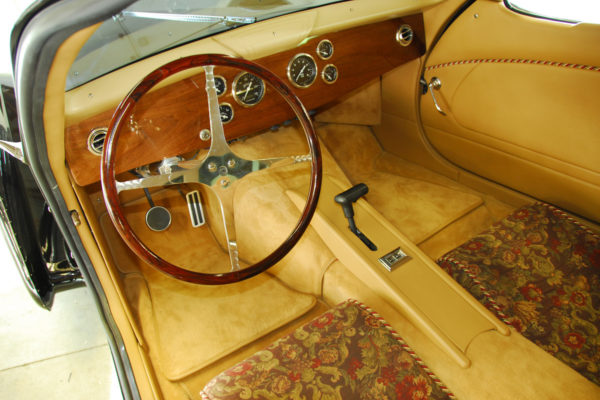
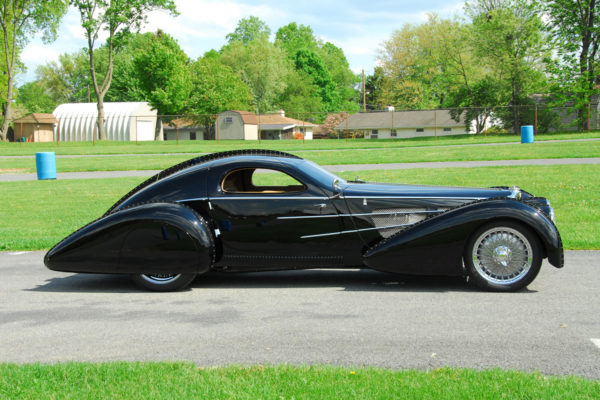
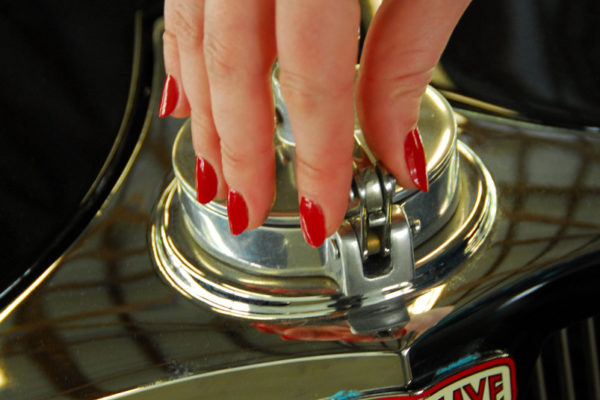
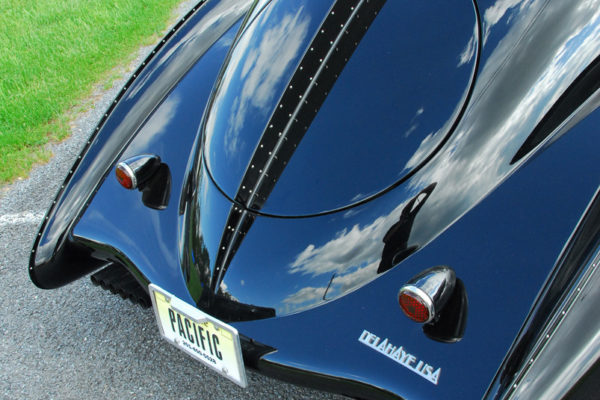
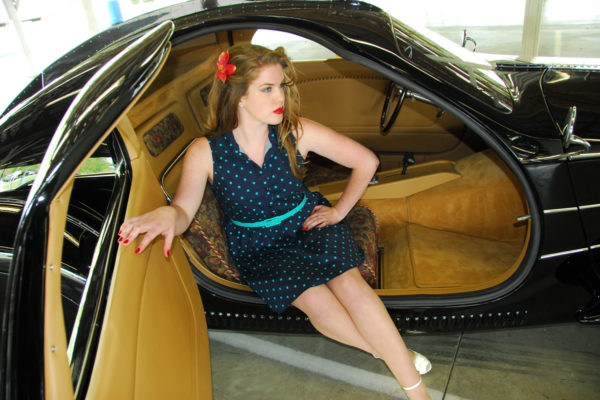
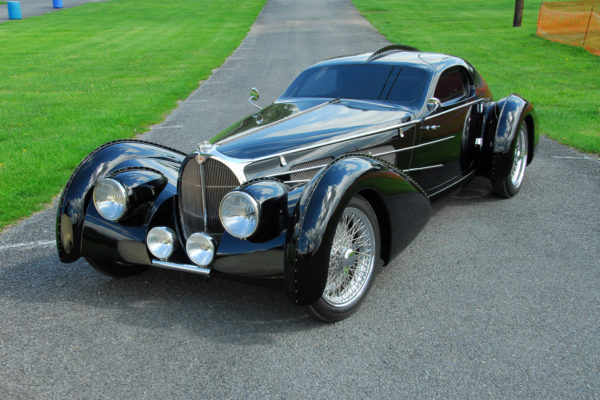
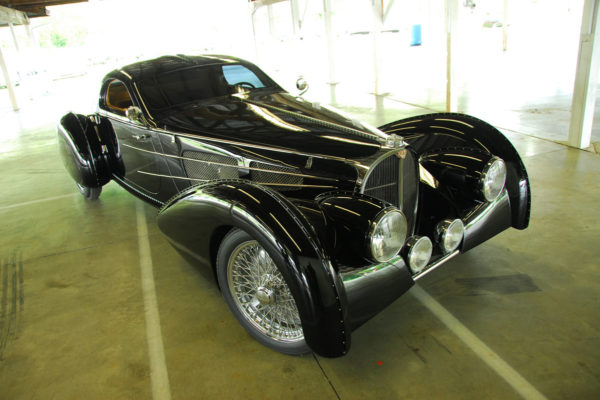
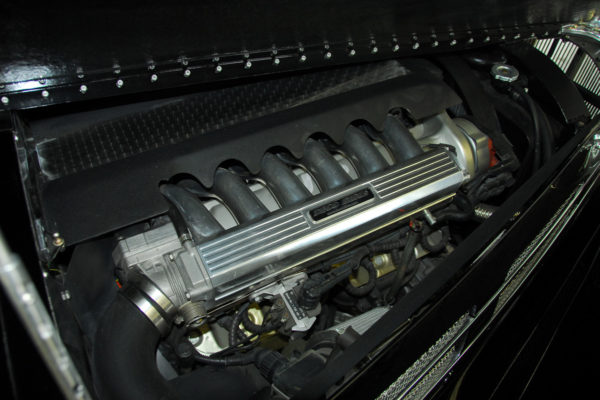
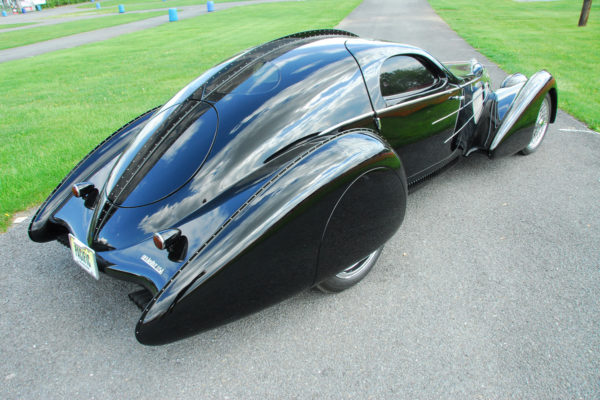
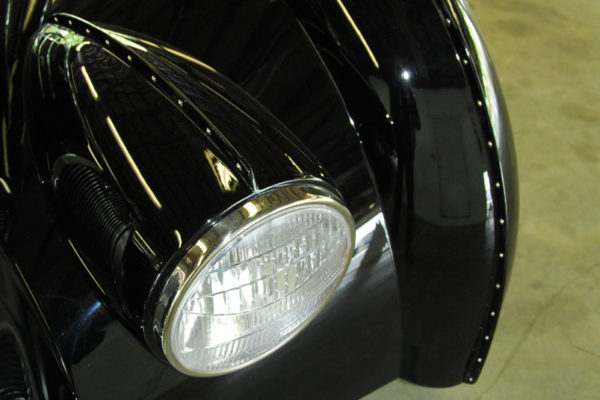
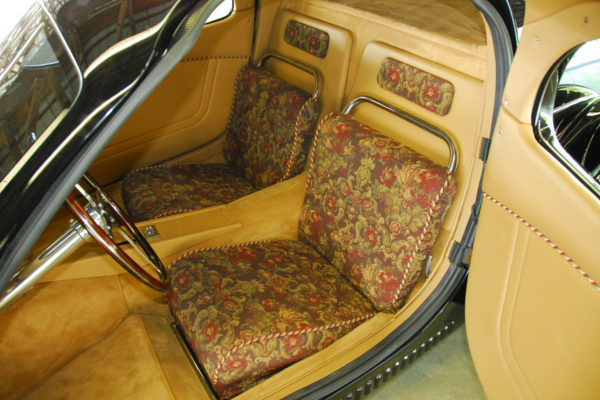
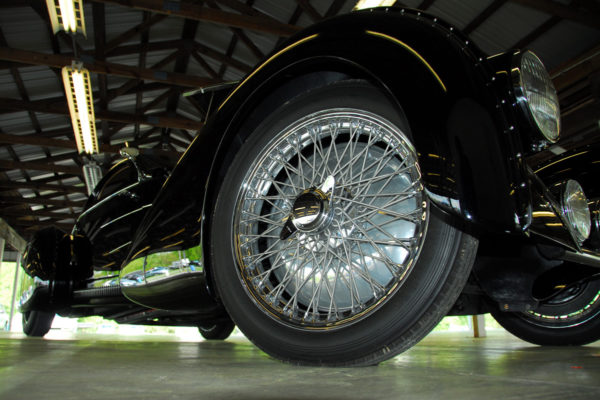
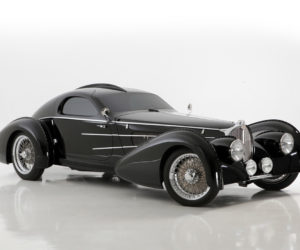
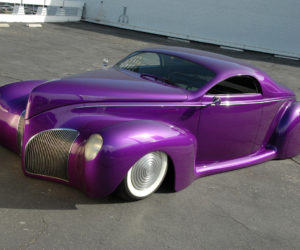
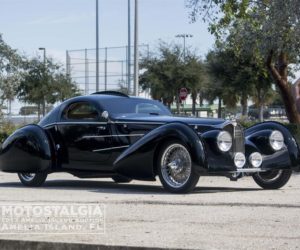
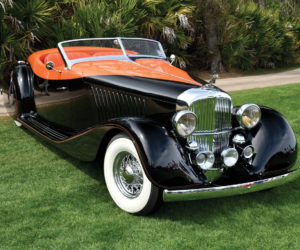




Comments for: TRIBUTE RODS
comments powered by Disqus